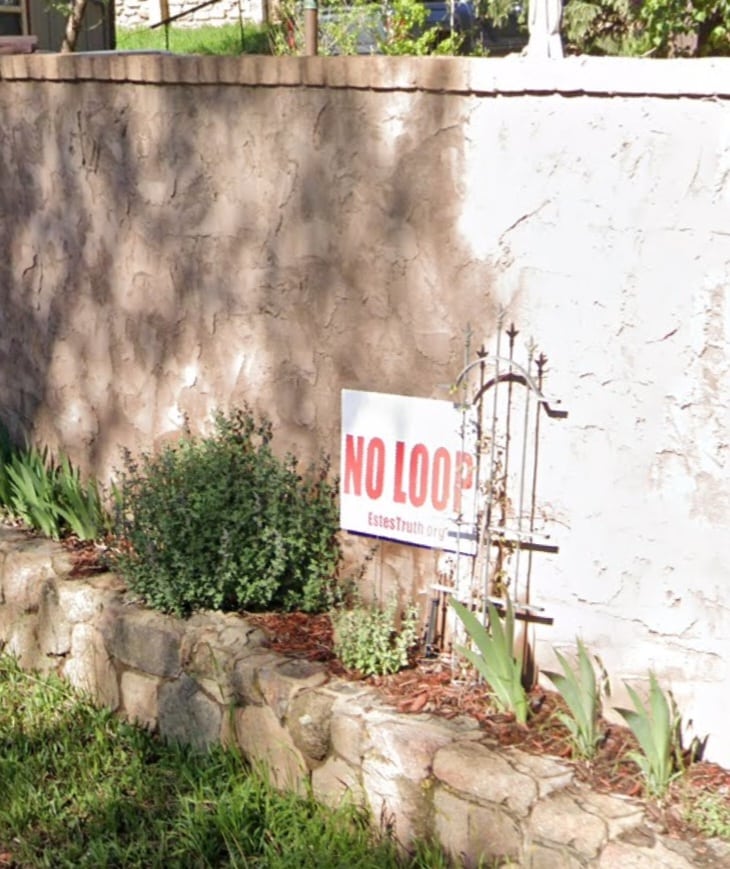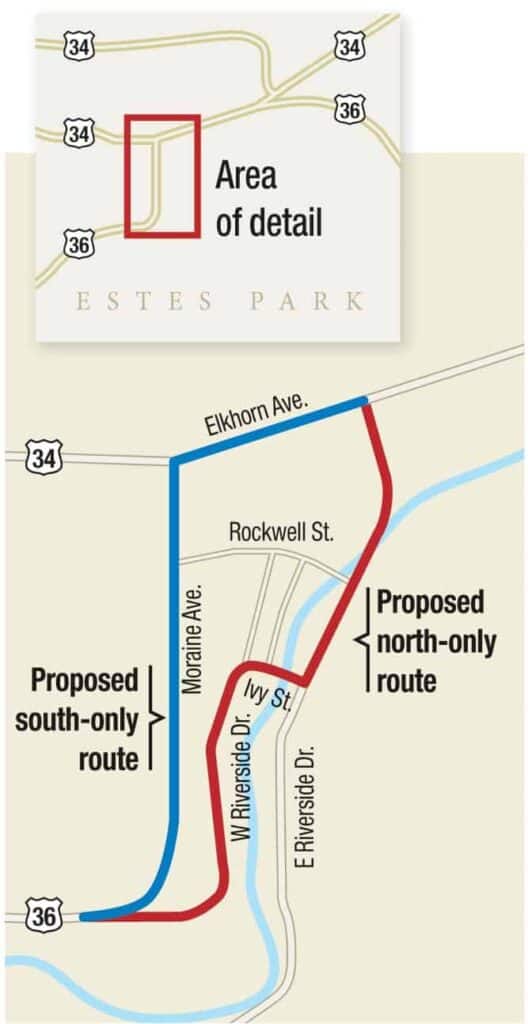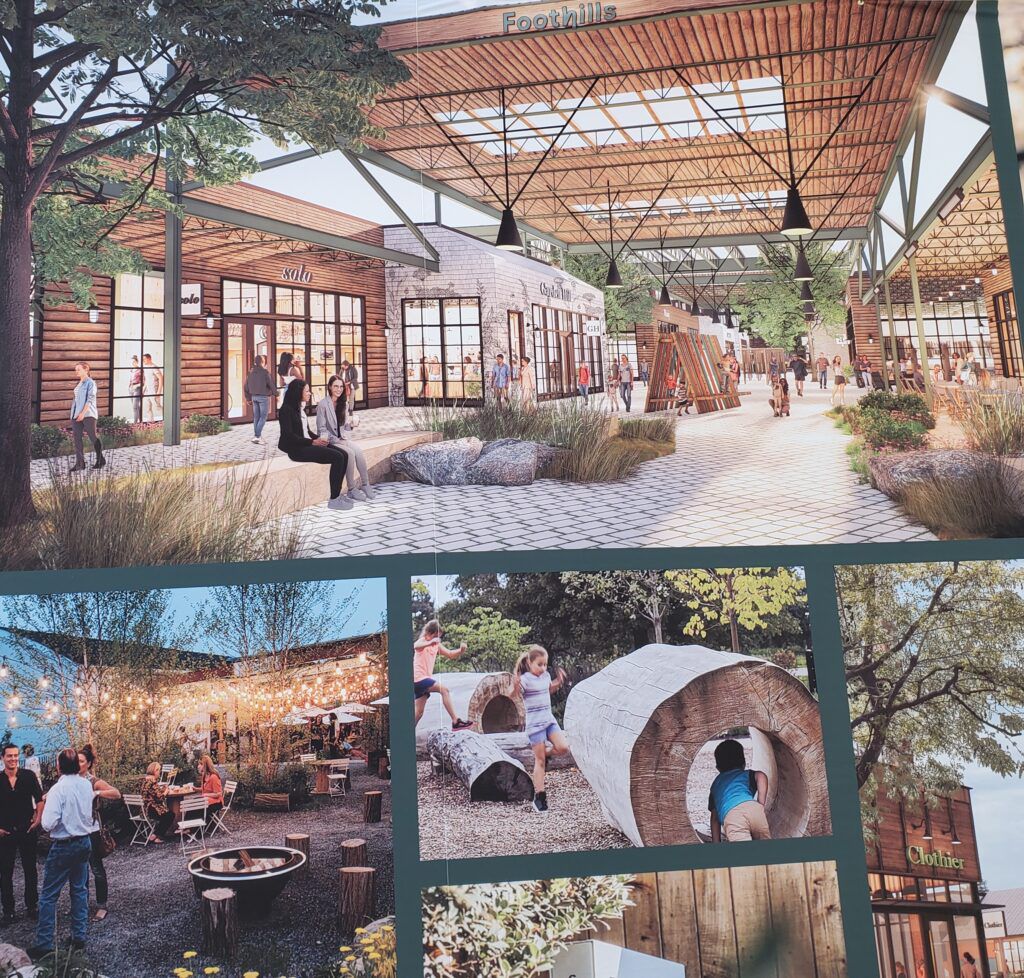Estes OKs spending more to launch Loop project
ESTES PARK – Still showing the scars left by nine years of controversy, the Downtown Estes Loop got a $1 million shot in the arm Thursday night.
With only Trustee Marie Cenac dissenting, the Estes Park Board of Trustees voted to kick in more money to help cover construction costs for the Loop, the proposed one-way couplet that came in far above estimates, and get the work started in early 2023.
Public Works Director Gregory Muhonen had stunned trustees in October when he revealed that the lowest of two bids he received to complete the project – more than $27 million – far exceeded the $15.7 million estimate consulting engineers had made in July.
At a study session on Nov. 8, Muhonen presented the board with three options in the face of the $11.3 million overrun: Kill the hotly debated Loop altogether and give up the chance to use the millions in matching federal funds, wait six months to a year and advertise for bids again in hopes the construction industry would stabilize and offer a better price, or kickstart the Loop by spending an extra $1 million of the town’s money to match an extra $1 million from the Colorado Department of Transportation’s Responsible Acceleration of Maintenance and Partnerships (RAMP) program and a supplementary infusion of $9.3 million from the Federal Lands Access Program.
FLAP was developed to help speed tourist traffic to and from national parks and monuments. and Estes Park applied for a grant from the program in 2013 to relieve summer congestion as visitors travel through the town to enter or leave Rocky Mountain National Park.
Construction originally was expected to start in 2016, but fierce community controversy and a lengthy process for acquiring additional rights of way for the project delayed the scheduled start of work until 2018, then 2021. New Federal Emergency Management Agency modeling and mapping procedures for the revised floodplains within the project, triggered by the September 2013 Front Range deluge, further delayed permit applications and pushed the start of construction back two more years.
Under the plan for the 0.9-mile Estes Downtown Loop, westbound U.S. Highway 36 traffic, toward the park, will use its currently designated route — west along Elkhorn Avenue through the downtown core of tourist shops and restaurants, then south and west on Moraine Avenue — but eastbound U.S. 36 will be diverted at the Moraine Avenue curve through a new roundabout onto one-way northbound West Riverside Drive, across a new bridge over the Big Thompson River at Ivy Street, then north on East Riverside Drive to reconnect with Elkhorn on downtown’s eastern edge. Moraine Avenue will be one-way southbound from Elkhorn to Riverside.
Loop proponents have pointed to the opportunity to snare FLAP funding to mitigate the ever-increasing summer traffic headaches as tourists head for a national park that has become the nation’s third-most-visited, drawing more than 4.6 million visitors in 2019 and prompting the establishment of a timed-entry program to reduce the crowding. The project also would include building flood-resilient infrastructure at two bridges along Riverside and widening and deepening the Big Thompson River’s channel. That work would alter the designated floodplain, decreasing flood-insurance premiums for more than 20 properties.
Opponents countered that the plan would disturb the peace of homes, rental cottages and two city parks along Riverside, as well as hurting businesses along East Elkhorn, the main downtown commercial street, by speeding tourists leaving the park out of town and away from its economic generators. To get back to the downtown core, they argued, eastbound tourists leaving the park would have to circle back around — and town residents also would have to deal with the inconvenience of the counterclockwise pattern during the offseason when the summer congestion the Loop was meant to alleviate doesn’t exist.
With the flames of that opposition fanned by the announced cost overrun, trustees at the Nov. 8 study session voted to hold a special meeting a week later to hear public comments in the wake of the cost overrun, and either decide the issue themselves or ask Estes Park voters to decide the future direction of the project.
At that special meeting Thursday night, trustees heard Muhonen strongly defend the third option – spending the extra money and completing the Loop – out of what he said was “deep concern for the future vitality of Estes Park.”
Town staff calculated that it would cost about $35,000 to submit the issue to voters next March, and two of the four Estes Park residents who stepped to the microphone to voice opposition to the Loop asked trustees to put the issue to a public vote. However, Trustee Patrick Martchink told the audience that “the vote was made when you elected the seven of us.”
Five of the nine citizens who commented expressed support for the Loop.
Noting that the Central Federal Lands Highway Division required $1 million matches from CDOT and the town to get the extra $9.3 million in federal money, Muhonen told trustees, “When you’re spending someone else’s money, you have to play by their rules and their timelines.”
Acknowledging that 18 to 24 months of disruptive roadwork in the downtown core would cause aggravation, Muhonen said “I believe it’s a sound investment” and “the pain of construction is worth the positive outcome.”
Reminding trustees that canceling the project wouldn’t save any taxpayer money because the FLAP construction funds would be reallocated to other projects in other communities and that the federal government’s proposed investment of more than $26 million in Estes Park downtown infrastructure would be lost, Muhonen said spending the extra town money would not only complete the Loop but would be the fastest path to providing new roadway and parking surfaces downtown, four new traffic signals, expanded sidewalks for public safety, trails, bike lanes, a new bridge across the Big Thompson River, a flood overflow and stormwater collection system; a new roundabout intersection and a 16-inch domestic water distribution pipe for improved fire protection. Muhonen said the memorandum of understanding provides a reward to the contractor for finishing the project early and a penalty for finishing late.
Some trustees tempered their support with caution.
“This traffic pattern was not my favorite, and it’s really hard to be representative because we’re so fiercely divided,” said Trustee Kirby Hazelton. “We could use the $1 million for other things, but matches we can’t use for anything else.”
Trustee Barbara MacAlpine said “we’ll have to hold our breath and see how it works,” and Trustee Cindy Younglund noted that “I don’t like the cost increase, but I think we need to move forward.”
What bolstered her support for the Loop, Younglund said, was hearing a visitor say “I love Estes so much, but we won’t be back because of the traffic.”
Mayor Wendy Koenig, who said she wanted to correct the notion that trustees never considered putting the Loop to a vote “because, in fact, we did,” also reminded those in attendance that she had “voted against the project every time the town board had a discussion or a vote.
“There’s someone sitting here who had huge reasons why I didn’t think it was good for the community, and many of those involved the concerns of many of the businesses downtown and the direction of the flow of traffic,” she said. But now, she added, “I feel good because I’ve seen it progress and the value actually increase beyond traffic in the downtown corridor.”
Only Cenac remained firm in her opposition, branding the Loop “a bad idea from the beginning. I hope all the naysayers are wrong,” she said, “but every time we hear about it, they want more money.”
For Mayor Pro Tem Scott Webermeier, however, the choice was clear.
“We have to address these things,” he said. “A week ago I was throwing money at Powerball, and this is a much more sure bet.”
Source: BizWest




